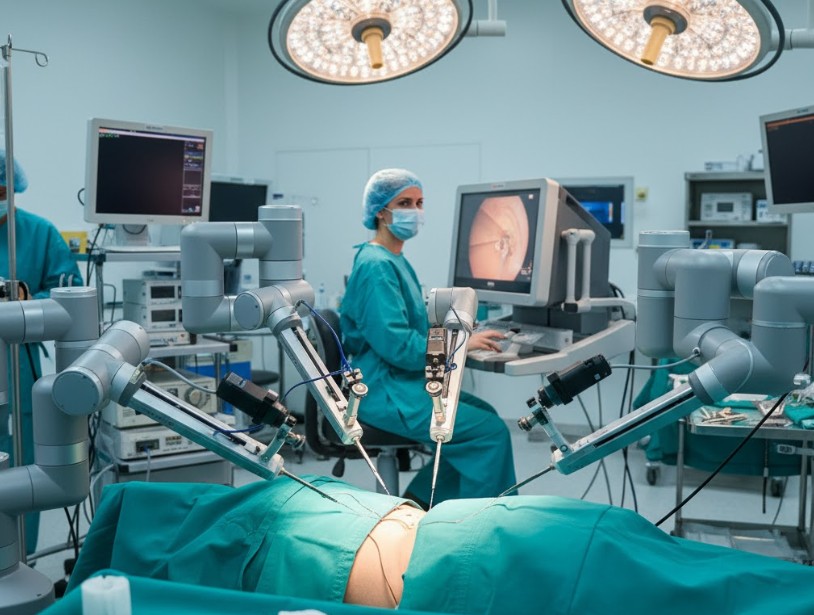
06 Oct Robotic Surgery in Gynecology: A Safer, Smarter Way to Heal
Gynecological conditions like fibroids, endometriosis, and ovarian cysts can cause severe discomfort, pain, and fertility challenges for women. Traditionally, open surgeries were used to treat these issues, leading to large incisions, longer hospital stays, and delayed recovery.
However, with advancements in medical technology, robotic surgery in gynecology has revolutionized women’s health care. Combining precision, safety, and faster recovery, this cutting-edge surgical technique offers a new ray of hope for countless women.
Dr. Usha M Kumar, one of the best robotic gynecologists in Delhi, has been at the forefront of this revolution, offering highly advanced and patient-centered robotic surgeries for various gynecologic disorders.
What Is Robotic Surgery in Gynecology?
Robotic surgery in gynecology is a type of minimally invasive surgery performed using the da Vinci Surgical System. This robotic platform allows surgeons to perform delicate and complex procedures through tiny incisions, offering unmatched precision and control.
The surgeon operates from a console, controlling robotic arms equipped with miniature surgical instruments and a high-definition 3D camera. This technology allows for movements far more precise than the human hand, minimizing errors and tissue damage.
Conditions Treated with Robotic Gynecologic Surgery
Robotic surgery is an excellent choice for treating a variety of gynecological issues, such as:
-
Uterine fibroids
-
Endometriosis
-
Ovarian cysts
-
Adenomyosis
-
Pelvic organ prolapse
-
Gynecologic cancers (uterine, cervical, ovarian)
-
Severe menstrual pain and bleeding disorders
Dr. Usha M Kumar specializes in using robotic surgery for both benign and complex gynecologic conditions, offering personalized care for every patient.
Advantages of Robotic Surgery in Gynecology
-
Smaller Incisions
Unlike open surgeries, robotic-assisted surgeries require only a few small incisions, reducing scarring and pain. -
High Precision
The robotic system’s enhanced dexterity allows for meticulous dissection and suturing, even in difficult-to-reach areas. -
Less Blood Loss
The precision of robotic instruments minimizes bleeding and reduces the risk of infection. -
Faster Recovery
Patients typically return to their normal routines much quicker compared to traditional surgery. -
Reduced Hospital Stay
Most patients can go home within 24 hours of surgery, depending on the procedure. -
Better Visualization
The 3D high-definition camera provides magnified views of the surgical site, ensuring greater accuracy and safety.
Robotic Surgery vs. Traditional Laparoscopy
| Feature | Robotic Surgery | Traditional Laparoscopy |
|---|---|---|
| Precision | Enhanced 3D vision and wristed instruments | Limited range of motion |
| Surgeon Control | Complete control from a console | Direct manual control |
| Accuracy | Highly precise with reduced tremor | Depends on surgeon steadiness |
| Recovery Time | Faster | Moderate |
| Cosmetic Results | Minimal scarring | Small scarring |
While both are minimally invasive, robotic surgery offers greater precision, flexibility, and comfort — making it the preferred choice for complex gynecological surgeries.
Why Choose Dr. Usha M Kumar for Robotic Gynecologic Surgery?
Dr. Usha M Kumar is a renowned robotic gynecologist in Delhi with vast experience in advanced minimally invasive and robotic procedures. Her commitment to patient safety, compassionate care, and use of state-of-the-art robotic systems ensures optimal outcomes for every woman.
Her expertise includes:
-
Robotic hysterectomy
-
Robotic myomectomy (fibroid removal)
-
Robotic ovarian cystectomy
-
Robotic endometriosis excision
-
Robotic cancer surgeries
Dr. Usha’s approach focuses on preserving fertility, reducing postoperative pain, and ensuring quicker return to daily life.
Recovery After Robotic Gynecologic Surgery
Recovery from robotic surgery is generally smoother and quicker.
What to expect:
-
Mild discomfort for a few days
-
Return to work within 1–2 weeks (depending on surgery type)
-
Minimal postoperative restrictions
-
Faster healing of small incisions
Dr. Usha provides detailed aftercare guidance, ensuring patients recover comfortably with minimal complications.
Myths About Robotic Surgery – Busted
Myth 1: Robots perform the surgery on their own.
Fact: The surgeon controls every movement of the robotic instruments. The system enhances, not replaces, human precision.
Myth 2: Robotic surgery is unsafe.
Fact: It’s one of the safest forms of minimally invasive surgery, approved worldwide for its accuracy and reduced risks.
Myth 3: It’s only for complicated cases.
Fact: Robotic surgery is suitable for a wide range of gynecologic conditions, not just complex ones.
FAQs About Robotic Surgery in Gynecology
Q1. Is robotic surgery painful?
No, robotic surgery causes minimal pain compared to open surgery due to smaller incisions and less tissue damage.
Q2. How long does robotic gynecologic surgery take?
The procedure duration varies but usually lasts between 1–3 hours, depending on complexity.
Q3. When can I resume normal activities after surgery?
Most patients can return to light activities within a few days and resume full activities within 2–3 weeks.
Q4. Is robotic surgery safe for older women?
Yes. It’s safe for most age groups, provided the patient is medically fit for surgery.
Q5. Does robotic surgery cost more?
While it may cost slightly more initially, the quicker recovery and reduced hospital stay make it cost-effective in the long run.
Conclusion
Robotic surgery in gynecology has completely transformed how women’s health issues are treated today. It offers a safer, smarter, and faster recovery compared to traditional surgical methods. For women dealing with fibroids, endometriosis, or other gynecologic conditions, robotic surgery provides hope for a pain-free future and improved quality of life.
If you’re looking for the best robotic gynecologist in Delhi, Dr. Usha M Kumar combines world-class expertise with compassionate care to help women heal faster and live healthier.




Sorry, the comment form is closed at this time.